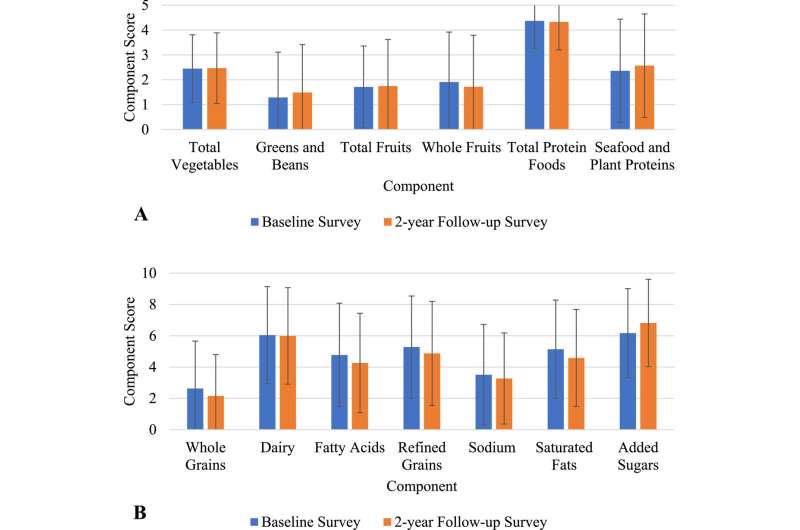Healthy Eating Index-2015 (HEI-2015) mean scores and SDa scored out of 5 (A) and 10 (B). aPanel A components have a maximum score of 5, and Panel B components have a maximum score of 10. Higher scores indicate greater conformance with the 2015–2020 Dietary Guidelines for Americans. HEI-2015 component scores of moderation are reverse-scored and include refined grains, sodium, added sugars, and saturated fats. Credit: Journal of Nutrition Education and Behavior (2023). DOI: 10.1016/j.jneb.2023.10.003
Diet quality among adolescents in the United States is among the worst across all age groups, putting young people at risk for heart attack, stroke, and diabetes, among other cardiometabolic diseases later in life. The research brief shared in the Journal of Nutrition Education and Behavior used the Healthy Eating Index-2015 and medical testing to assess a group of youth aged 10-16 years.
This study examined data from the Translational Investigation of Growth and Everyday Routine in Kids cohort. This study measured physical activity, sleep, and overall dietary guidelines for youth living in metropolitan areas of Louisiana, which are typically medically underserved and characterized by high poverty levels, food insecurity, obesity, and related diseases. Study participants provided a baseline data set with follow-up measures two years later.
Corresponding author Amanda E. Staiano, Ph.D., Pennington Biomedical Research Center, Louisiana State University, explained, "Examining the data related to diet quality may help identify targets for future interventions in families, homes, and communities. Effective and timely interventions focusing on adherence to dietary guidelines are necessary for improving diet quality and reducing health risks."
Of the 342 eligible and enrolled adolescents, the final study sample included 192 participants with complete baseline and follow-up data. At baseline and follow-up, the adolescents were asked to wear an accelerometer for at least seven days and complete two 24-hour dietary recalls for their food and beverage intake during research visits that included body composition, blood pressure, and clinical chemistry measurements and anthropometrics.
Kathy Hu and Alyssa M. Button, PhD, discuss findings that showed adolescents with poor adherence to the 2015-2020 Dietary Guidelines for Americans and associated cardiometabolic risk factors continued these same patterns over the two years of the study, suggesting that the adverse effects of a poor-quality diet had already established the health risks these teenagers will face throughout life. Credit: Journal of Nutrition Education and Behavior
Considering overall eating patterns, the findings showed that adolescents with poor adherence to the 2015-2020 Dietary Guidelines for Americans and associated cardiometabolic risk factors continued these same patterns over the two years of the study, suggesting that the adverse effects of a poor-quality diet had already established the health risks these teenagers will face throughout life.
Dr. Staiano concluded, "This study found specific dietary quality patterns associated with adolescent cardiometabolic risk factors. Promotion of nutrition knowledge is necessary, but knowledge is not consistently linked with food consumption behavior. Identifying barriers to consuming a healthful diet and investigating effective strategies to overcome these barriers may curtail future health risks."
More information: Kathy Hu et al, Adolescent Diet Quality, Cardiometabolic Risk, and Adiposity: A Prospective Cohort, Journal of Nutrition Education and Behavior (2023). DOI: 10.1016/j.jneb.2023.10.003
Journal information: Journal of Nutrition Education and Behavior
Provided by Elsevier
























